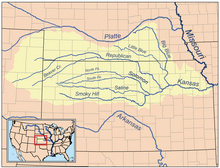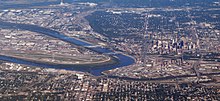Kansas River
| Kansas River Kaw River, Padouca River, Riviere de Commanches o Padocas[1] | |
|---|---|
 The Kansas River at De Soto, Kansas | |
 Map of the Kansas River drainage basin | |
| Location | |
| Country | United States |
| State | Kansas |
| Physical characteristics | |
| Source confluence | |
| • location | Junction City, Kansas |
| • coordinates | 39°03′35″N 96°48′04″W / 39.05972°N 96.80111°W |
| • elevation | 1,041 ft (317 m) |
| Mouth | Missouri River |
• location | Kansas City, Kansas |
• coordinates | 39°06′55″N 94°36′38″W / 39.11528°N 94.61056°W[1] |
• elevation | 718 ft (219 m) |
| Length | 148 mi (238 km) |
| Basin size | 60,114 sq mi (155,690 km2) |
| Discharge | |
| • average | 7,240 cu ft/s (205 m3/s) |
| • minimum | 353 cu ft/s (10.0 m3/s) |
| • maximum | 133,172 cu ft/s (3,771.0 m3/s) |
| Basin features | |
| Tributaries | |
| • left | Republican River, Big Blue River, Delaware River |
| • right | Smoky Hill River, Wakarusa River |
The Kansas River, also known as the Kaw, is a meandering prairie
The
Course
Beginning at the confluence of the
Drainage
The Kansas drains 34,423 square miles (89,160 km2) of land in Kansas (almost all of the northern half), along with 16,916 square miles (43,810 km2) in
Geology
The Kansas River flows through what is known as the Stable Interior region. Since this region is near the center of the North American Plate, it has not experienced any extensive geologic faulting, folding, or mountain building in recent geologic time. From the confluence at Junction City, the river flows through limestone, shale, mudstone, and occasional sandstone strata that, except for diagenesis, remain largely undisturbed since deposition in shallow Carboniferous and Permian seas. The age of the rock exposed by the river becomes progressively older as the river moves downstream for two main reasons. First, downstream areas experience more erosion from increased flow, and second because the slight uplift of the Ozark dome to the southeast caused the strata in Kansas to dip very slightly to the west. The Smoky Hill River and Republican River tributaries reach far to the west into the Cretaceous deposits of the Western Interior Seaway and the Neogene Period deposits of material from the uplift of the Rocky Mountains, which created the Ogallala Formation.[10]
All of the rocks in the eastern Kansas valley are
History


The first map showing the Kansas River is French
From June 26 through 29, 1804, the Lewis and Clark Expedition camped at Kaw Point at the Kansas River's mouth. They praised the scenery in their accounts and noted the area would be a good location for a fort.
In August 1819, Maj. Stephen H. Long steered the first steamer into the Kansas River with his 30-ton boat Western Engineer. He made it scarcely a mile up the river before turning back, citing mud bars from the recent floods.
The mouth of the Kansas River in the West Bottoms area of Kansas City (at a longitude of 94 degrees 36 minutes West) was the basis for Missouri's western boundary from Iowa to Arkansas when it became a state in 1821 (Kansas entered the Union in 1861.) South of the Missouri River, that longitude still remains the boundary between Kansas and Missouri. North of the Missouri River, the state of Missouri extended its boundary further to the west in 1836 with the Platte Purchase. The river has moved slightly since this designation, but the state boundary has remained the same. This line is known as the Osage Boundary.[12]
From the 1840s through the early 1870s, the southern ridgelines of the lower section of the Kansas River were the beginnings of the Oregon, California, and Santa Fe trails as they left Kansas City.
Beginning in 1854, steamboats operated regularly from Kansas City to Lawrence and Topeka, and sometimes as far as
On February 25, 1864, the state legislature declared the Kansas River nonnavigable, allowing railroad and bridge companies to build bridges and dams without restriction. The first train to operate in Kansas south of the Kansas River did so by crossing the river in Lawrence on November 1, 1867.[14] This law remained in effect until 1913, when, after it had been characterized as "a crime against the public welfare of Kansas", it was finally repealed and the river's status was restored to a navigable stream. The status has not since changed, though modern commercial navigation on the river is largely confined to dredging.
Recreation
Recreation along the Kansas River includes fishing, canoeing and kayaking, and rowing. There are 18 public access points along the river. The Friends of the Kaw organizes many float trips down the river each year (as well as cleanup efforts), and the Lawrence KOA rents canoes for self-guided trips. At least two rowing teams regularly use the river: The University of Kansas rowing team uses the pool above the Bowersock Dam for their training, and the Kansas City Boat Club as well as University of Missouri-Kansas City rows in the final stretches of the river, near its mouth and the connection to the Missouri River.[15]
River modifications
On the river
- Kansas City: A few yards downstream from the I-435 bridge, a weir diverts water to an intake for WaterOne. Portage access is on the left bank.
- Lawrence: Bowersock Dam is the largest obstruction on the river. It serves not only to create a standing pool for one of Lawrence's municipal water intakes (the other is at Clinton Lake), but also to create a head for the Bowersock Mills & Power Company. At this site, the Bowersock Mills & Power Company operates the only hydroelectric power station in Kansas: a 2.5-megawatt low-impact hydropower facility.[16] The University of Kansas's rowing team uses the pool for its exercises. Portage access is on the left bank.
- Tecumseh: An easily navigable low head weir diverts water to the Tecumseh power plant, just downstream from Topeka.
- Topeka: A Topeka water department dam diverts water to the right bank for a municipal water intake. Portage access is on the left bank.
Within the watershed
The
control, with secondary recreational uses.In popular culture
The river is featured prominently in the 2017 documentary When Kings Reigned, directed by
Étienne de Veniard Sieur de Bourgmont's expedition into the Kansas River valley and the history of the Kanza people in their villages along the river is discussed in The Last Wild Places of Kansas, a book by George Frazier.[18]
In
Johnny Kaw is a fictional Kansas settler created in a series of tall tale publications started in 1955 — one of his fictional feats was to have dug the Kansas River Valley.
The "Kaw River" is mentioned as a location in the western series Wagon Train, in the opening scene of The Tom Tuckett Story episode (March 2, 1960).
Places and locations along the river
(Listed from mouth upstream)
Counties
- Wyandotte and Johnson (boundary in part)
- Jefferson and Douglas (boundary)
- Shawnee
- Pottawatomie and Wabaunsee (boundary)
- Riley
- Geary
Cities and towns
| City | Elevation | |
|---|---|---|
| ft | m | |
| Kansas City | 730 | 220 |
| Shawnee | 732 | 223 |
| Edwardsville | 741 | 226 |
| Bonner Springs | 762 | 232 |
| De Soto | 764 | 233 |
| Lawrence | 791 | 241 |
| Lecompton | 820 | 250 |
| Perry | 820 | 250 |
| Tecumseh | 840 | 260 |
| Topeka | 852 | 260 |
| Willard | 889 | 271 |
| Belvue | 911 | 278 |
| Wamego | 955 | 291 |
| St. George | 977 | 298 |
| Manhattan | 990 | 300 |
| Ogden | 1,023 | 312 |
Ft. Riley
|
1,040 | 320 |
| Junction City | 1,047 | 319 |
| Boldface denotes a major city | ||
Tributaries
See also
References
- ^ a b U.S. Geological Survey Geographic Names Information System: Kansas River
- ^ "Kansas Historical Quarterly – A Review of Early Navigation on the Kansas River – Kansas Historical Society". Kshs.org. Retrieved 2012-08-15..
The Encyclopedia of Kansas (1994) ISBN 0-403-09921-8Connelley, William E. 1918. Indians Archived 2007-02-11 at the Wayback Machine. A Standard History of Kansas and Kansans, ch. 10, vol. 1
- ^ "Why is Kansas City located in Missouri instead of Kansas?". Archived from the original on July 16, 2010. Retrieved January 2, 2010.
- ^ "Kansas history page". Retrieved 2006-11-28.
- ISBN 0-403-09921-8
- ^ a b U.S. Geological Survey. National Hydrography Dataset high-resolution flowline data. The National Map Archived 2012-03-29 at the Wayback Machine, accessed May 31, 2011
- ^ environmental news service
- ^ a b "KGS--Kansas River Corridor--Geology". www.kgs.ku.edu. Retrieved 10 April 2018.
- ^ Lengths of major rivers Archived 2009-03-05 at the Wayback Machine
- ^ "KGS Map M-118--Surficial Geology of Kansas" (PDF). Kansas Geological Survey. 2010.
- ^ "A Review of Early Navigation on the Kansas River - Kansas Historical Society". www.kshs.org. Retrieved 10 April 2018.
- ^ "CONTENTdm". digital.library.okstate.edu. Retrieved 10 April 2018.
- ^ Andreas, A. T. (1883). Andreas, A. T. History of the state of Kansas (Supplementary History and Description of its Counties Cities Towns and Villages). Chicago. p. 1301. Retrieved 2019-08-01.
... the State. During the territorial days of Kansas steamboats came up the river to Manhattan and as far as Junction City and should the Mississippi, Missouri, and Kansas rivers, under the fostering care of the General Government, receive bountiful appropriations, the bulky products of the soil are likely lo be transported in floating barges down these improved navigable streams to the Gulf of Mexico, where they may be readily shipped to the Old World.
{{cite book}}: CS1 maint: location missing publisher (link) - ^ Harold J. Henderson (August 1947). "The Building of the First Kansas Railroad". Kansas Historical Society. Archived from the original on December 16, 2018. Retrieved May 25, 2019. The Kansas Historical Quarterly, August 1947 (Vol. 15, No. 3), pages 225-239.
- ^ "About". Kansas City Boat Club. 2012-07-24. Retrieved 2018-12-01.
- ^ "Small Hydro". National Hydropower Association. 2019. Retrieved 2019-09-28.
- ^ "When Kings Reigned (2017)". Retrieved 10 April 2018 – via www.imdb.com.
- ISBN 9780700622207.
External links
- Bowersock Mills & Power Company
- Kaw Point
- Kaw Valley Heritage Alliance
- USGS
- Lower Kansas
- Midwestern Secret
- USGS: Map of Historical & Cultural Sites along Kaw Valley
- . New International Encyclopedia. 1905.


